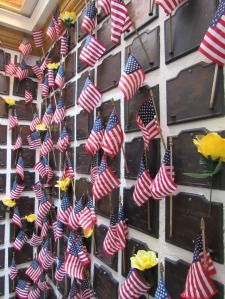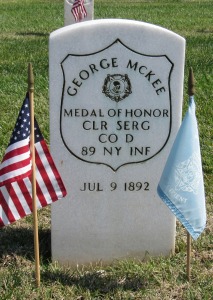There are certainly more-popular cemeteries in the Los Angeles area. Cemeteries with more scenic views, more statues, more celebrities. But none are more important, more wonderful, more emotional and more humbling than Los Angeles National Cemetery. I went to visit just before Memorial Day this year. (And you can click on the pics to biggerize them.)
Memorial Day, the last Monday in May, is a federal holiday to remember and honor those who died while serving in the nation’s armed forces. (Not to be confused with Veterans’ Day, which is a celebration of all who served.)
So, it’s not really “Happy Memorial Day.” It’s a time for us to remember and honor those who gave their lives in the service of their country.
Los Angeles National Cemetery, one of 147 National Cemeteries in the U.S., covers about 114 acres at the intersection of Wilshire and Sepulveda boulevards, and was formally dedicated on May 22, 1889.
The cemetery was originally a 20-acre site for the burial of residents of the Sawtelle Veterans Home, a residence for disabled soldiers. Eighty-year-old Abner Prather, a member of the 4th Indiana Infantry and a veteran of the Mexican-American War, was the first internment, on May 11, 1889.
The Los Angeles National Cemetery property, surrounded by Westwood and the I-405 freeway, expanded over the years, and currently contains about 86,000 burials. The cemetery has been closed for new burials for more than 10 years, except for the spouses of those already interred.
The U.S. Department of Veterans Affairs has obtained about 13 additional acres, and plans are in the works to allow for new burials, although all of the new internments will be cremated remains in the walls of columbaria, which will be built over time – one every 10 years for the next 90 years.
Every year, volunteers, including Boy Scout and Girl Scout troops, place American flags on each of the 86,000 graves, prior to the Memorial Day ceremonies at the cemetery. This year, the Memorial Day service will be held on Monday, May 25, and usually attracts several thousand visitors to pay their respects. You should go. Seriously. It’s not a big celebrity site, but it’s extremely important and powerful.
Los Angeles National Cemetery is the final resting place for veterans who served in the Mexican-American War, the Civil War, the Spanish-American War, World War I, World War II, and in Korea, Vietnam, Iraq and Afghanistan. There are also two canine burials at Los Angeles National Cemetery, although this practice is prohibited today. Old Bonus, an adopted pet of residents in the old soldiers’ home, and Blackout, a war dog wounded in the Pacific during World War II, are both buried at Los Angeles National.
Los Angeles National Cemetery also contains the remains of more than 100 Buffalo Soldiers – African-American soldiers who were members of the cavalry during the Civil War.
Visit if you ever have the chance, here or at any National Cemetery. Pay your respects to the men and women who volunteered to serve and defend their country. Not all of them died in the line of duty, of course, but all of them were willing and prepared to make the ultimate sacrifice.
It’s also amazing to see the incredible precision of the grave markers. You can look down a row for hundreds of yards, and not see a marker out of place by as much as a fraction of an inch.
And on Memorial Day, as on any day, at any cemetery, you’ll see people visiting family members – fathers, mothers, sons, daughters, brothers, sisters, aunts, uncles, cousins. But it’s especially emotional here, because so many of those buried here were lives cut short in their prime.
This is the small columbarium at Los Angeles National Cemetery. Based on the expansion plans, it will soon become the first of many.
Each of the markers on the outside of the columbarium is decorated with a Memorial Day flag.
The inscription over the entrance to the columbarium.
Each of the niches inside the columbarium was also adorned with a flag.
And, yes, there are some celebrities at the Los Angeles National Cemetery. Howard McNear, who served in the U.S. Army Air Corps during World War II, is best known as barber Floyd Lawson on “The Andy Griffith Show.”
Los Angeles National Cemetery contains the remains of 14 recipients of the Medal of Honor, the nation’s highest military honor. (They’re the real celebrities here.) William F. Lukes, a native of Bohemia, received the honor, according to his citation, “for extraordinary heroism in action while serving with Company D, attached to the U.S.S. Colorado, during the capture of the Korean forts, 9 and 10 June 1871.”
James Sweeney, a native of England, was awarded the Medal of Honor “for extraordinary heroism on 19 October 1864, while serving with Company A, 1st Vermont Cavalry, in action at Cedar Creek, Virginia. With one companion Private Sweeney captured the State flag of a North Carolina regiment, together with three officers and an ambulance with its mules and driver.” He was 18 years old at the time. Like Lukes and other Medal of Honor recipients, Sweeney’s grave is also decorated for Memorial Day with a blue Medal of Honor flag.
George McKee, who was born in Ireland, was honored, “for extraordinary heroism on 2 April 1865, while serving with Company D, 89th New York Infantry, in action at Petersburg, Virginia, for gallantry as Color Bearer in the assault on Fort Gregg.” And, for the record, the Medal of Honor isn’t “won.” It’s not a competition. It’s “awarded” by Congress, and “received.” They aren’t “Medal of Honor winners,” they’re “Medal of Honor recipients.” And it’s not the “Congressional Medal of Honor.” It’s just the “Medal of Honor.” Class dismissed.





















